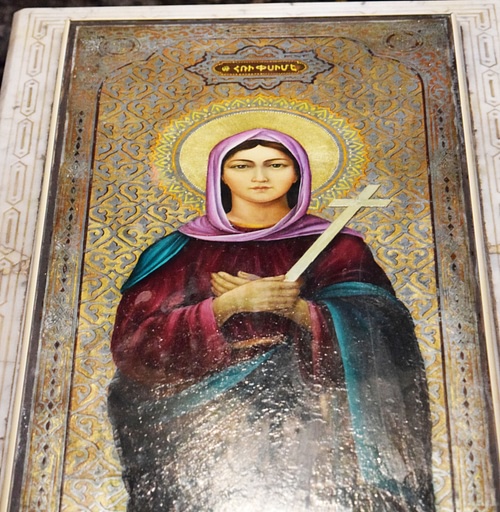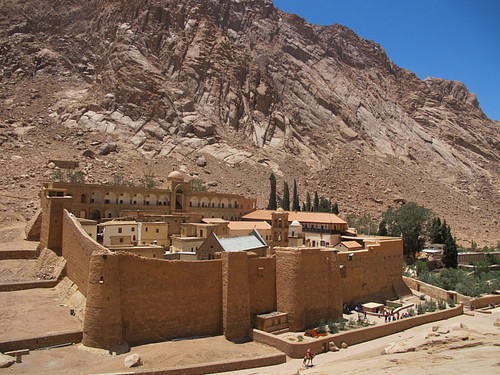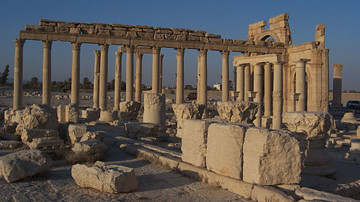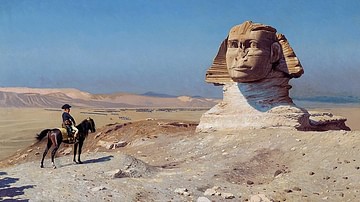Medievalists retain misconceptions and myths about Oriental Christians. Indeed, the fact that the Middle East is the birthplace of Christianity is an afterthought for many. During the Middle Ages, Christians from different creeds and confessions lived in present-day Lebanon, Syria, Israel, and Palestine. Here, they constructed churches, monasteries, nunneries, and seminaries, which retain timeless artistic treasures and cultural riches.
James Blake Wiener speaks to Dr Mat Immerzee to clarify and contextualize the artistic and cultural heritage of medieval Christians who resided in what is now the Levant.
Dr Immerzee is a retired Assistant Professor at Universiteit Leiden and Director of the Paul van Moorsel Centre for Christian Art and Culture in the Middle East at Vrije Universiteit Amsterdam.
JBW: The largest Christian community in what is present-day Lebanon is that of the Maronite Christians – they trace their origins to the 4th-century Syrian hermit, St. Maron (d. 410). The Maronite Church is an Eastern Catholic Syriac Church, using the Antiochian Rite, which has been in communion with Rome since 1182. Nonetheless, Maronites have kept their own unique traditions and practices.
What do you think differentiates medieval Maronite art and architecture from other Christian sects in the Levant? Due to a large degree of contact with traders and crusaders from Western Europe, I would suspect that we see “Western” influence reflected in Maronite edifices, mosaics, frescoes, and so forth.
MI: Especially in the 13th century, the oriental Christian communities enjoyed an impressive cultural flourishing which came to expression in the embellishment of churches with wall paintings, icons, sculpture, and woodwork and the production of illustrated manuscripts, but what remains today differs from on one community or region to another. In Lebanon, several dozens of decorated Maronite and Greek Orthodox churches are encountered in mountain villages and small towns in the vicinity of Jbeil (Byblos), Tripoli, the Qadisha Valley, and by exception in Beirut, but only a few still preserve substantial parts of their medieval decoration programs. Most churches fell into decay after the Christian cultural downfall in the early 14th century when the pressure to convert became stronger. While many church buildings were left in the state they were, others were renovated in the Ottoman period or more recently.

Remarkably Oriental Christian art displays broad uniformity with some regional and denominational differences. Cut off from the East Roman (Byzantine) Empire after the Arab conquest, it also escaped from the Byzantine iconoclastic movement (726-843 CE), which allowed the Middle Eastern Christians to develop their artistic legacy in their own way. An appealing subject is the introduction of warrior saints on horseback such as George and Theodore from about the 8th century. The West and the Byzantine Empire had to wait until the Crusader era to pick up this oriental motif and make it a worldwide success. But the borrowing was mutual. Mounted saints painted in Maronite, Melkite (Greek Orthodox), and Syriac Orthodox churches would increasingly be equipped with a chain coat and rendered with their feet in a forward thrust position, a battle technique developed within Norman military circles. Moreover, the Syrian equestrian saints Sergius and Bacchus were rendered holding a crossed ‘crusader’ banner, an attribute usually associated with Saint George, as if they were Crusader knights. Apart from these examples, there is little evidence of Oriental susceptibility to typically Latin subjects. We find Saint Lawrence of Rome represented in the Greek Orthodox Monastery of Our Lady near Kaftun, but this is exceptional.
Normally, one cannot tell from wall paintings in Lebanon to which community the church in question belonged. They all represented the same subjects and saints whose names are written in Greek and/or Syriac and may have recruited painters from the same artistic circles. Regarding architecture, the last word has not been said on this matter, because the documentation of medieval Lebanese church architecture is still in progress. Nevertheless, the build of some churches undeniably displays Western architectural influences; for example, the Maronite Church of Saint Sabas in Eddé al-Batrun is even plainly Romanesque in style.
JBW: Following my last question, is it then correct to assume that the Crusader lands – Edessa, Antioch, Tripoli, and Jerusalem – were quite receptive to Eastern Christian styles?
MI: That is difficult to tell because there is next to nothing left in the former County of Edessa and the Principality of Antioch. We do have some decorated churches in the former Kingdom of Jerusalem (Abu Gosh, Bethlehem), and here we see a strong focus on Byzantine craftsmanship and Latin usage. Apart from the preserved church embellishment in the Lebanese mountains, there are some fascinating, stylistically and thematically comparable instances across the border with Syria.
Although situated within Muslim territory, the Qalamun District between Damascus and Homs stands out for its well-established Greek Orthodox and Syriac Orthodox populations; and from the 18th century onwards, also Greek Catholics and Syrian Catholics. Interestingly, stylistic characteristics confirm that indigenous Syrian painters were also involved in the decoration inside Crusader fortresses such as Crac des Chevaliers and Margat Castle in Syria. It was obviously easier to contract local manpower than to find specialists in Europe.
JBW: The Byzantine Empire exuded tremendous political, cultural, and religious sway across the Levant throughout the Middle Ages; a sizable chunk of the Christian population in both Syria and Lebanon still adheres to the rituals of the Greek Orthodox Church even today.
MI: Leaving aside the cultural foundations laid before the Arab conquest, the contemporary Byzantine influences can hardly be overlooked. In the 12th and 13th centuries, itinerating Byzantine-trained painters worked on behalf of any well-paying client within Frankish and Muslim territory, from Cairo to Tabriz, irrespective of their denominational background. This partly explains the introduction of some ‘fashionable’ Byzantine subjects and the Byzantine brushwork of several mural paintings and icons. Made in the 1160s, the Byzantine-style mosaics in the Church of the Nativity at Bethlehem are believed to be the result of Latin-Byzantine cooperation at the highest levels; they exhale the propagandistic message of Christian unity. In 1204, however, the Crusaders would conquer Constantinople and substantial parts of the Byzantine Empire. The Venetians brought the bounty to Venice, and, surprisingly, also to Alexandria with the consent of the sultan in Cairo, intending to sell the objects in the Middle East. So much for Christian unity…
The Eastern Greek Orthodox Church has its roots in the Chalcedonian dispute about the human and divine nature of Christ in 451, which resulted in the dogmatic breakdown of the Byzantine Church into pro- and anti-Chalcedonian factions. Like the Maronites, the Melkites (‘royalists’) remained faithful to the former, official Byzantine standpoint, except for their oriental patriarchs in Antioch, Alexandria, and Jerusalem were officially allowed autonomy without direct interference from Constantinople. On the other hand, the Syriac Orthodox became dogmatically affiliated with the identically ‘Miaphysite’ Coptic, Ethiopian, and Armenian Churches. To complicate matters even more, part of the Greek Orthodox and Syriac Orthodox communities joined the Church of Rome in the 18th century. This resulted in the establishment of the Greek Catholic and Syriac Catholic Churches.

JBW: Could you tell us a little bit more with regard to the Syriac Orthodox Church? If I’m not mistaken, there was a flourishing of the building of churches and monasteries by Syriac Orthodox communities once they fell under Muslim rule around 640.
MI: As a Miaphysite community, the Syriac Orthodox enjoyed the same protected status as other non-Muslim communities under Muslim rule. This allowed them to establish an independent Church hierarchy headed by their patriarch who nominally resided in Antioch, which covered large areas in Iran, Iraq, Turkey, and Syria. Some of their oldest churches, with architectural sculpture and occasionally a mosaic, are situated in the Tur Abdin region in Southeast Turkey. Remarkably, around the year 800, a group of monks from the city of Takrit (present-day Tikrit in Iraq) migrated to Egypt to establish a Syriac ‘colony’ within the Coptic monastic community. Their ‘Monastery of the Syrians’ (Deir al-Surian) still exists and is one of Middle Eastern Christianity’s key monuments for its architecture, wall paintings, icons, wood- and plasterwork ranging in date from the 7th to the 13th centuries. The monastery also houses an extensive manuscript collection. Another decorated monastery is the Monastery of St Moses (Deir Mar Musa; presently Syriac Catholic) near Nebk to the north of Damascus, where paintings from the 11th and 13th-centuries can still be seen. The Monastery of St Behnam (Deir Mar Behnam; presently Syriac Catholic) near Mosul is reputed for its 13th-century architectural sculpture and unique stucco relief, but unfortunately, a lot has been destroyed by ISIS warriors.
The Syriac Orthodox presence in Lebanon remained limited to a church dedicated to Saint Behnam in Tripoli, and the temporary use of a Maronite church dedicated to St Theodore at the village of Bahdeidat by refugees from the East who were on the run from the Mongols during the 1250s. This church still displays its complete decoration program from this period. It is impossible to tell which community arranged the refurbishment, but the addition of a donor figure in Western dress testifies to support from a (probably) local Frankish lord. Finally, the Syriac Orthodox also excelled in manuscript illumination, examples of which can be found in Western collections and the patriarchal library near Damascus.
JBW: As the Lebanese and Syrian Greek Orthodox Churches had fewer dealings with Western Europeans than the Maronite Church, does medieval Christian Orthodox art in Lebanon and Syria reflect and maintain the designs and styles of medieval Byzantium? If so, in what ways, and where do we see deviation or innovation?
MI: As I said before, Byzantine-trained artists have been surprisingly active in the Frankish states and beyond, especially during the 13th century. I prefer to label them as “Byzantine-trained” instead of “Byzantine,” because it is not always clear where they came from. To mention an example, painters from Cyprus still worked in the Byzantine artistic tradition but no longer fell under the authority of the emperor after the Crusader conquest of the island in 1291. Culturally they were still fully Byzantine, but, speaking in modern terms, they would have had the Frankish-Cypriot nationality. The little we can say from the preserved paintings is that some Cypriot artists traveled to the Levant in the aftermath of the power change in search of new clientele. It is unknown if they stayed or returned after the accomplishment of their tasks, but around the mid-13th century we see the birth of a ‘Syrian-Cypriot’ style which combines Byzantine painting techniques with typically Syrian formal features and designs; for example, in the afore-mentioned Monastery at Kaftun in Lebanon. Typically, instances of this blended art are not only encountered in Lebanon and Syria but also in Cyprus.

Focusing on the shared elements in Oriental Christian and Byzantine art, the example of apse decorations illustrates the resemblances and often also subtle differences. From the Early Christian period, the common composition in the apse behind the altar consisted of the mystical appearance of Christ (Christ in Glory) between the Four Living Creatures in the conch and the Virgin between saints, such as the apostles and Church fathers, in the lower zone. However, an early variant encountered in Egypt renders the biblical Vision of Ezekiel: here, Christ in Glory is placed on the fiery chariot the prophet saw. Recent research has brought to light that this variant was also applied in Syriac Orthodox churches in Turkey and Iraq as late as the 13th century. Medieval oriental conch paintings often combine Christ in Glory with the Deesis, that is, the Virgin and St John the Baptist pleading in favour of mankind. Whereas the Byzantines kept these subjects separated, the ‘Deesis-Vision’ is encountered from Egypt to Armenia and Georgia in churches of all denominations
JBW: One cannot discuss medieval Christian art in the Near East without making some mention of Armenians and Georgians. The first recorded Armenian pilgrimage occurred in the early 4th century, and Armenian Cilicia (1080-1375) flourished at the time of the Crusades. During the reign of Queen Tamar (r. 1184-1213), Georgia assumed the traditional role of the Byzantine crown as a protector of the Christians of the Middle East. Armenians and Georgians intermarried not only with one another but also with Byzantines and Crusaders.
Where is the medieval Armenian and Georgian presence the strongest in the Levant? Is it discernible?

MI: Medieval Armenian and Georgian art can be found in their homelands, but there are also surviving works testifying to their presence in the Levant and Egypt. Starting with the Armenians, they have always lived in groups dispersed throughout the Middle East, whereas in Jerusalem they have their own quarter. A 13th-century wooden door with typically Armenian ornamentation and inscriptions in the Church of the Nativity in Bethlehem testify to the interest Armenians took in the Holy Land. Further to the south, a 12th-century mural painting with Armenian inscriptions in the White Monastery near Sohag reminds us of the strong Armenian presence in Egypt under Fatimid rule during the 11th to 12th centuries. They had arrived in the wake of the rise of power of the Muslim Armenian warlord and later Vizir Badr al-Jamali, who seized all power in the Fatimid realm during the 1070s. He not only brought his own army consisting of Christian and Muslim Armenians but also made Egypt a safe home for Armenians from more troubled areas.
The Christian Armenians had their own monastery and used a number of churches in Egypt. However, these were appropriated by the Copts at the downfall of Fatimid power and the subsequent expulsion of all Armenians during the 1160s. The Armenian catholicos or head of Egypt is known to have left for Jerusalem taking with him all the church treasures.
At the White Monastery, a mural was made by an artist named Theodore originating from a village in Southeastern Turkey on behalf of Armenian miners who were apparently allowed to use the monastery’s church. It is hard to believe that Theodore came all the way to accomplish just one task in this remote place. There can be no doubt that he decorated more Armenian churches during his stay in Egypt, but the Copts thoroughly wiped out all remaining traces of their previous owners.
The Georgian presence was limited to Jerusalem, where they owned the Monastery of the Holy Cross until it was taken over by the Greek Orthodox in the 17th century. In the monastery’s church, a series of 14th-century paintings with Georgian inscriptions are a reminder of this period. In addition, an icon representing St George and scenes of his life painted during the early 13th century, and kept in the Monastery of Saint Catherine in the Sinai, was a gift from a Georgian monk, who is himself depicted prostrating at the saint’s feet.

JBW: Because we touched upon the incorporation of outside artistic influences coming from Western Europe and Byzantium to the Levant, I wondered if you might offer a final comment or two on those architectural or artistic influences coming from the Arab World or even the wider Islamic world.
To what extent did Levantine Christians – who often lived near their Muslim neighbors – adopt or assimilate Islamic styles of art and architecture?
MI: The earliest examples of Islamic art from the Umayyad era display strong influences of Late Antiquity, which in turn had also been the source of inspiration to early Christian art. Over the course of time, these artistic relatives would gradually grow apart to meet again on specific occasions. The earliest example of Islamic-inspired Christian art is the purely ornamental stucco reliefs in the Monastery of the Syrians in Egypt. Constructed during the early 10th century by the Abbot Moses of Nisibis. Its plastered altar room exudes the same atmosphere as houses in the 9th-century Abbasid capital of Samarra and the similarly decorated Mosque of Ibn Tulun (an Abbasid prince who came to Egypt as its governor) in Cairo.

The decoration of Fatimid-era sanctuary screens in Coptic churches and woodwork from Egyptian Islamic, Jewish, and secular contexts are fully interchangeable; likewise, 13th-century architectural sculpture, manuscript illustrations, and metalwork from the Mosul area display the same shared stylistic and iconographic artistic language. Broadly speaking, we are obviously dealing with craftsmen working on behalf of different parties at the local level regardless of their religious backgrounds. Occasionally, one comes across ‘Islamic’ ornaments in wall paintings, but the overall impression is that Christian painting was subject to blatant conservatism when compared to more fashionable, ‘neutral’ items of interior decoration. The only Arabic inscriptions found in mural paintings concern texts commemorating building or refurbishment activities, or graffiti left by visitors. There obviously was a difference in status between the vernacular spoken language and the Church’s Greek and Syriac.
JBW: Dr. Mat Immerzeel, thanks so much for your time and consideration.
MI: You are welcome; it is my pleasure to contribute to your magazine.
Mat Immerzeel has been active in the Middle East since 1989, first in Egypt, then in Syria and Lebanon, and recently in Cyprus. His main field of study is the material culture of Oriental Christian communities from the 3rd century to the present. In particular, he studies wall paintings, icons, stone and plaster sculpture, woodwork, and manuscript illustrations. He has participated in research projects focusing on the formation of religious communal identity, the training of local collection curators, and restoration and documentation campaigns. He is the Director of the Paul van Moorsel Centre for Christian Art and Culture in the Middle East and editor-in-chief of the journal Eastern Christian Art (ECA) published by Peeters Publishers in Leuven, the Netherlands.









